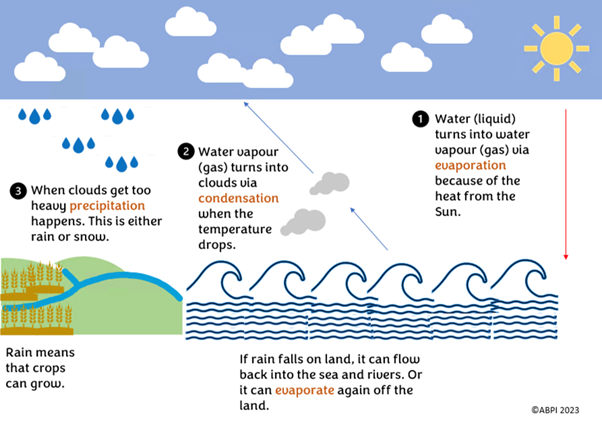This topic takes on average 45 minutes to read.
There are a number of interactive features in this resource:
 Biology
Biology
 Chemistry
Chemistry
 Physics
Physics
 Science
Science
Every living thing on the planet needs water to survive and be healthy - we need it to drink and to grow our crops as plants need water to grow. However, climate change means that water isn’t as available as it needs to be in some countries.
To understand this, it is important to understand the water cycle and where rain comes from.
All water on the planet moves around and changes states depending on the temperature.
When the temperature increases, water from the land, sea and rivers turns into water vapour, which is a gas.
This happens through a process known as evaporation.
Water vapour itself is a greenhouse gas, and even though it’s production is natural, through evaporation, the Earth getting hotter means that it is being made more quickly.
This then increases the Earth’s temperature even more as more water vapour stops the heat from the Sun returning to space.
At lower temperatures, water vapour turns into clouds in a process called condensation.
Clouds will be blown by the wind to travel to different places, collecting more and more water through evaporation. Eventually, they become too heavy and it rains.

The rain is called precipitation. The water can fall as snow too, if the temperature is even lower. The rain or snow falls into rivers, seas or on land, and the cycle will start again.
Watch the videos below which explain changing states of water and reversible and irreversible changes. Think about how this could relate to the water cycle.

Reversible and non-reversible changes.
Some changes are reversible.
Once you have changed something you can change
it back.
Like melting ice to liquid then refreezing
it again.
Some changes are non-reversible.
Once you have changed something you can not
change it back, like cooking an egg.
Or mixing flour and milk.
Or burning a match.
Changing states of water.
When the water is boiling we see bubbles but these are not bubbles of air they are bubbles of water that have changed state to a gas.
This happens at approximately 100 degrees celsius.
You need to give the water energy, heat, to turn it into a gas.
If you change the amount of heat it can change how fast the water changes state into a gas.
Because the earth is getting hotter, condensation doesn’t happen as much. This means that water evaporates, drying the land, but never turns from the water vapour gas back into the liquid water needed for rain.
This leads to droughts. As plants need water to grow, this can mean that crops cannot grow, and famine can happen.
Click the boxes below to see the how the water cycle is affected by climate change.